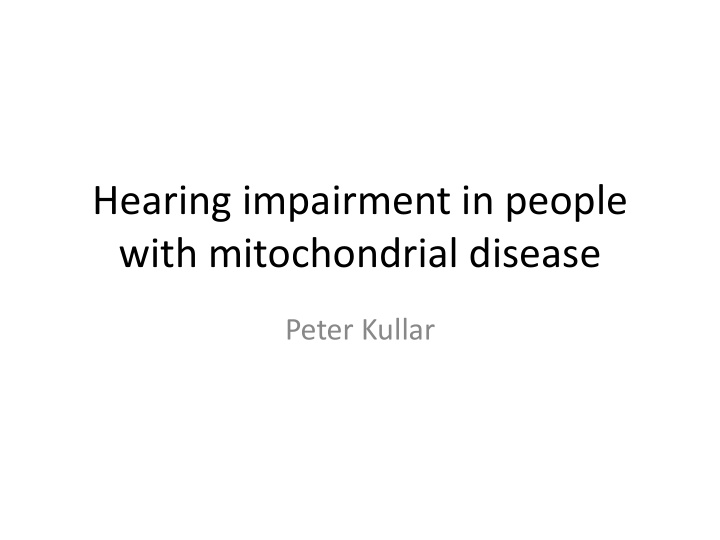



Hearing impairment in people with mitochondrial disease Peter Kullar
Objectives • Overview of hearing loss in people with mitochondrial disease – Causes – Treatment options – Current research – Questions
Ear anatomy
Ear anatomy
Sound wave Hair Cells Nerve
Mitochondria • The powerhouses of the cell (with lots of other functions too) • Understanding why mitochondrial disease leads to hearing loss is the focus of my research
Hearing loss • Can be ‘sensorineural’ or ‘conductive’ • Hearing loss in mitochondrial disease is sensorineural • Mitochondrial problems also play a part in age related hearing loss
Mitochondrial disease • Many different diseases result from problems with mitochondria • Disease result from changes in the mitochondrial DNA • Or changes in the cell’s own DNA which makes many mitochondrial proteins/components
Spectrum of problems • Much variation in disease between patients and in families • Hearing loss can be the only symptom of disease or one symptom of many • Even with the same genetic changes patients can have very different symptoms
• Up to 1/3 of people with mitochondrial disease can have normal hearing (for their age) • The rest have a spectrum of hearing loss ranging from very mild to profound deafness
• Hearing loss likely results from problems in the energy generation of the mitochondria • Role of environmental effects
Assessment of hearing • In UK - Referral from GP to ENT clinic or directly to audiology • Test of hearing using audiometer ‘press the button when you hear the sound’
Pure tone audiometry (PTA)
Treatment • Hearing aids • Cochlear implantation • The future?
Hearing aids • A hearing aid is an electronic, battery- operated device that amplifies and changes sound to allow for improved communication
Components of Hearing Aids • Microphone: Receives sound and converts it into electrical impulses. • Amplifier: Intensifies electrical impulses. • Receiver: Translates those electrical impulses into louder sounds • Battery: power source for device. Some hearing aids also have earmolds (earpieces) to direct the flow of sound into the ear and enhance sound quality.
3 Basic Types of Hearing Aids • Conventional: Increases volume of all incoming sound with some minor adjustments possible. • Programmable Analog • Digital: It automatically adapts to multiple listening and sound environments. Provided free of charge on the NHS
Hearing Aid Styles • Behind-the-Ear (BTE) (available on the NHS) • In-the-Ear (ITE) • In-the-Canal (ITC) • Completely-in-Canal (CIC)
Behind-the-Ear (BTE) • BTE hearing aids are worn behind the ear and are connected to a plastic earmold that fits inside the outer ear. • The components are held in a case behind the ear. Sound travels from the aid through the earmold into the ear. • BTE aids are used by people of all ages for mild to profound hearing loss.
Other aids
Private vs NHS • Suitability for different devices • Quality of audiology testing • Cost • Waiting times
Problems with hearing aids • Feedback • Infections • Cosmetic issues (but any different to spectacles?)
Cochlear implantation (CI)
• Hearing Aids: s: – acoustically amplify sound – rely on the responsiveness of surviving hair cells • Coch chlear Implants: s: – bypass damaged hair cells Convert the acoustic input signal into electrical impulses to stimulate the auditory nerve fibres in the cochlea. The resulting electrical sound information is sent through the auditory system to the brain for interpretation.
Suitability for CI • Bilateral severe to profound sensorineural hearing loss • Limited benefit from appropriate hearing aids • Patient relies heavily on speech reading or note writing to understand speech • Communication issues • Other medical problems – complex in Mt disease
Other considerations • Age • Duration of deafness • Mode of Communication • Other handicaps • Motivation
Audiological Assessment • Diagnostic testing: – Audiogram and specialised hearing tests • Speech perception tests with appropriate amplification • Counselling regarding types of implants and expectations
Surgery Risks and/ or Adverse Effects • Facial nerve injury (small risk) • Infection • Loss of any natural hearing in the operated ear • Pain/numbness • Temporary dizziness, tinnitus or taste disturbance • MRI precautions after surgery
After the surgery • Initial stimulation: 4-6 weeks post surgery • Adjustments made regularly based on feedback from patients, parents, therapists and educators • Rehabilitation to meet specific patient needs • Regular follow-up appointments
CI in Mitochondrial patients • First recorded case in 1997 (Japan, Kearns- Sayre syndrome) • Can be ideal patients as hearing loss may be only symptom and occurs after the development of language • Results vary but development of more sophisticated technologies are improving results
My research • Hearing tests in patients with different mitochondrial diseases • Specific interest in the A1555G mutation (antibiotic associated deafness) • For more information contact peter.kullar@newcastle.ac.uk
Recommend
More recommend